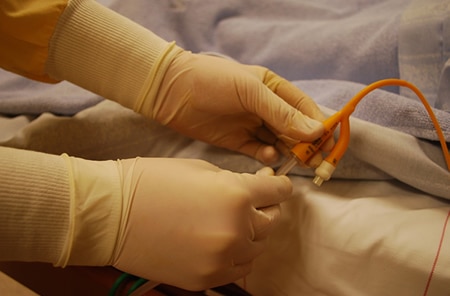What is a peripherally inserted central catheter?

A peripherally inserted central catheter, also known as a PICC line, is a long, thin, hollow plastic tube that inserted into an arm vein. A PICC line typically takes the place of a standard intravenous line, or IV, since it can stay in place for an extended period of time. Therefore, patients in the hospital will need fewer needlesticks during treatment.
A PICC will provide an effective method of drawing blood or delivering medications and nutrients into a patient’s bloodstream over a period of weeks or months. A PICC line can be easily removed when it is no longer needed. Allowing patients to feel more comfortable and at ease during their treatments.
Preparing for a PICC
Patients that require a PICC can prepare for catheter placement by following specific protocols before and the day of treatment. If you any any additional questions, you can speak with Dr. Jeffrey LeSueur. We recommend these preparation methods before a PICC:
- Refraining from food or liquids for 2 hours prior to the procedure. However, you may take all regular medications as scheduled with small sips of water.
- Report any current medications to the radiology nurse, including “blood thinners.” Your physician may advise you to stop taking them for a specific period of time before your procedure.
- Disclose if you are taking Coumadin or Heparin, or you have known or suspected liver disease. We may test your blood prior to your procedure to determine if your blood clots normally.
- Report any allergies to the radiology nurse, especially those to iodine contrast, x-ray dye, or local anesthetic medications.
- Inform the x-ray technologist if there is any possibility that you are pregnant. Many imaging tests are not performed during pregnancy so as not to expose the fetus to radiation.
Patient Testimonial
"I have worked in the health care profession for a long while and I have to say, that Summit went way above and beyond my expectations. Thank you so much for everything that you’ve done (and continue to do) for both your patients and their families. You guys are amazing!"
PICC Procedure
To start, patients that need a PICC will be positioned on their back so our staff can access their arm. First, a band is placed around the arm so we can see your veins. Additionally, we will set up an ultrasound to help guide the catheter into place. After choosing a vein, our staff will clean the area with an antiseptic solution and a large sterile sheet. Next, a local anesthetic is injected into the arm. This will numb the area before the catheter is inserted.
Then, the catheter is gently passed into and moved through the vein. It is advanced until the tip is in the large vein close to the heart. The opposite end will lay outside your arm. After the PICC is in place, an x-ray is taken to confirm the catheter’s position. Finally, our staff will secure the line to your skin with a bandage to avoid movement and keep it clean.
What can I expect after PICC placement?

If patients are not staying at the hospital when the PICC is placed they should plan for someone to drive them home. It is likely that patients will experience mild pain, some discomfort, and bruising at the injection site. To relieve these symptoms patients can take over the counter medications.
It is important to wash your hands before touching the catheter, limiting contact with the catheter, keeping your skin around the catheter clean and dry, and covering the catheter site with a sterile bandage in order to prevent infection. If you experience any complications or if the catheter falls out, gets shorter, or has a hole or a crack call your physician for assistance.
Caring For Your PICC
It is important to wash your hands before touching the catheter, limiting contact with the catheter, keeping your skin around the catheter clean and dry, and covering the catheter site with a sterile bandage in order to prevent infection. If you experience any complications or if the catheter falls out, gets shorter, or has a hole or a crack call your physician for assistance.
Risks of Peripherally Inserted Central Catheter
After the catheter placement patients can experience one or more of the following complications:
- Bleeding at the procedure site
- Infection at the procedure site
- Injury to the blood vessel
- Accidental insertion into an artery instead of a vein
- Nerve injury
- Temporary irregular heartbeat
- Blockage of a blood vessel leading to the heart
- Problems due to iodine contrast, including allergic reaction or kidney damage
